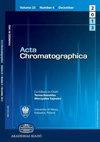A comprehensive assessment of the biological attributes of and analytical quantification methods for monosodium glutamate
IF 1.7
4区 化学
Q3 CHEMISTRY, ANALYTICAL
引用次数: 0
Abstract
This review focuses on monosodium glutamate which proclaims the fifth taste as “Umami”. Monosodium glutamate imparts a deep, meaty, umami flavour to foods. Asian cuisine frequently uses this flavouring, just as in the processed items produced across the United States and Europe. This article dealt with a detailed discussion of physicochemical features, pharmacological actions, and different reported analytical methodologies for the estimation of monosodium glutamate. Monosodium glutamate is analyzed using a variety of techniques, including spectroscopy, chromatography, electrochemistry, electrophoresis, chemometrics, flow injection analysis, and biosensors. According to results of comparative research of analytical methodologies, high performance liquid chromatography (HPLC) is most widely used method for analyzing monosodium glutamate which surpasses the gas chromatographic (GC) approach. All of the reported methods are accurate, precise, cost-effective, and sensitive. The European Union defined monosodium glutamate as a food additive that is permitted in some foods, but is subject to quantitative limits. Consequently, this study provides the analyst with an accessible path to quantifying monosodium glutamate's content for use in the food and pharmaceutical industries.谷氨酸钠生物属性和分析量化方法的全面评估
本评论的重点是谷氨酸钠,它宣称第五种味道是 "鲜味"。谷氨酸钠会给食物带来一种深沉、肉味和鲜味。亚洲菜肴经常使用这种调味料,美国和欧洲生产的加工食品也是如此。这篇文章详细讨论了谷氨酸钠的理化特性、药理作用以及报告的用于估算谷氨酸钠的不同分析方法。谷氨酸钠的分析技术多种多样,包括光谱学、色谱法、电化学、电泳、化学计量学、流动注射分析和生物传感器。根据分析方法的比较研究结果,高效液相色谱法(HPLC)是分析谷氨酸钠最广泛使用的方法,超过了气相色谱法(GC)。所有报告的方法都准确、精确、经济、灵敏。欧盟将谷氨酸钠定义为一种食品添加剂,允许在某些食品中使用,但有定量限制。因此,本研究为分析人员提供了一种可用于食品和制药行业的谷氨酸钠含量定量分析方法。
本文章由计算机程序翻译,如有差异,请以英文原文为准。
求助全文
约1分钟内获得全文
求助全文
来源期刊

Acta Chromatographica
化学-分析化学
CiteScore
4.00
自引率
0.00%
发文量
55
审稿时长
2.3 months
期刊介绍:
Acta Chromatographica
Open Access
Acta Chromatographica publishes peer-reviewed scientific articles on every field of chromatography, including theory of chromatography; progress in synthesis and characterization of new stationary phases; chromatography of organic, inorganic and complex compounds; enantioseparation and chromatography of chiral compounds; applications of chromatography in biology, pharmacy, medicine, and food analysis; environmental applications of chromatography; analytical and physico-chemical aspects of sample preparation for chromatography; hyphenated and combined techniques; chemometrics and its applications in separation science.
 求助内容:
求助内容: 应助结果提醒方式:
应助结果提醒方式:


